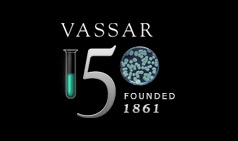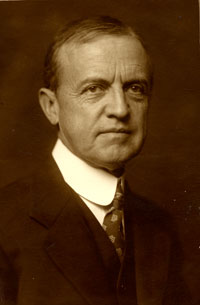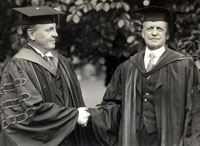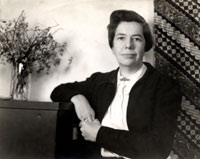The History of Economics at Vassar College
by Shirley Johnson-Lans, Professor of Economics and William Lunt, Associate Professor of Economics
February 2011
Department Website
The first economist hired to teach at Vassar was Professor Herbert Mills. (1890). He was formally a member of the History Department, although his initial title was Associate Professor of History and Economics. According to the Vassar Encyclopedia:
“Although Vassar had offered economics courses intermittently earlier, none had been offered for several years before Mills was hired, and previously the subject had been covered by professors from fields such as English literature. Mills was not only Vassar’s first economics professor, he was one of the first in the nation.”
Professor Mills was a specialist in Economic History, having written a prize winning PhD thesis entitled “The French Revolution in Santo Domingo.” (Cornell University, summa cum laude, 1890). During a forty-year career at Vassar he published several textbooks including one on labor economics, a book entitledPractical Questions in Economics, and a number of articles. He was quite progressive, in favor of women having freedom to choose professions and opposed to Prohibition. He was elected Chairman of the Faculty in 1914 and was also active in the greater Poughkeepsie Community, serving on the Dutchess County SPCA and Child Welfare boards. He was a President and Director of the Vassar Bank and President of the Poughkeepsie Board of Education from 1909 to1911.
In 1917, Mabel Newcomer, who would achieve considerable international fame, was added to the departmental faculty. Like Prof. Mills, Miss Newcomer had a forty-year tenure at Vassar (1917-1957). She received her PhD in 1913 from Stanford University, and because she had a dissertation fellowship from Columbia University, she spent some of her graduate years in New York City. This permitted her to expand her original thesis, on the California experiment with local government use of the property tax, to a dissertation which included a study of all states that had delegated the jurisdiction of property taxes to local government. Her experience at Columbia gave her contact with state and federal agencies and commissions with whom she would continue to work for years.
Although the introductory course, Economics 105, was officially a departmental course, it came to be known as “Miss Newcomer’s course.” She also taught more advanced classes in public finance and corporations. Miss Newcomer’s approach to economics would be best described as institutional (as opposed to theoretical) economics. She was very interested in having the students do empirical work and taught them statistics by having them measure such things as the average and variance in height and weight of Vassar (versus Mount Holyoke) students. She viewed economics as a broad field encompassing sociology and anthropology as well. The Vassar Economics Department, under her leadership, became the ESA (Economics, Sociology and Anthropology) Department during the 1940s.
Miss Newcomer wanted the students to be involved in community service, which she regarded as complementary with their academic studies. Students in the statistics classes frequently undertook surveys at the behest of local agencies. In the mid-forties, after years of struggling without an adequate budget, Miss Newcomer, under the leadership of President Sarah Blanding, prepared a grant proposal for the Carnegie Foundation which resulted in the establishment of the Vassar Field Work Office.
During her time at Vassar, Miss Newcomer had a number of research appointments and served on a large number of government agencies at both state and federal levels including her positions as special investigator to the New York State Joint Commission on Taxation and Retrenchment (1921-5), economist for the Educational Finance Inquiry (1922-3), and special investigator for the Regional Plan of New York (1925). In 1928 she began her long-term collaboration with Columbia University Professor Robert Haig, who directed the California State Tax Commission. From 1931 to 1933 she worked on the New York State Commission on Revision of the Tax Law. She was also active in projects on school financing and served on a panel of experts conducting a study of school finance in the United States for the Office of Education in the U.S. Department of the Interior. During World War II she was chosen by John Kenneth Galbraith, then on leave from his position in the Economics Department at Harvard, to be his assistant in Washington at the Office of Price Administration (OPA). And in June of 1944 she was chosen by Treasury Secretary Henry Morgenthau to be an American delegate (the only woman) to the United Nations Conference at Bretton Woods. This was the conference at which the International Monetary Fund (IMF) was conceived. Afterwards, Miss Newcomer was enlisted to “sell” the program to American women, and she traveled widely throughout the United States speaking to many groups.
Mabel Newcomer continued her active scholarship and teaching. In 1934 she received a Social Science Research Council Award to publish a study of the comparative distribution of tax funds by central governments to local governments in Germany and England. In 1935-7 she served as an Associate Director of the Twentieth Century Fund. Many summers she was invited to teach graduate courses at universities including Columbia and Stanford.
After Mabel Newcomer’s retirement in 1957, she remained on campus to write a book entitled, A History of American Women in Higher Education, a project funded in honor of the Centennial of Vassar College. In it she raised a number of important social questions: Why was the U.S. educating only 25 percent of the women capable of college work? Must early marriage deprive women of higher education? Were college educated women contributing enough to American scholarship and art? Was the shortage of scientists, doctors and other educated professionals due to a failure to utilize women's potential?
During the 1940's, the Vassar Economics Department’s approach to the discipline had gradually broadened beyond the institutional. As early as 1948, not without controversy, the department began to use Paul Samuelson’s introductory economics text which incorporated the Keynesian national income theory. The tenured professors during this period, in addition to Ms. Newcomer, included Emily Brown (Chicago PhD), Margaret Myers (Columbia PhD), Edna Macmahon (Brookings Institution PhD) and Howard Marshall (Columbia PhD). Ms. Myers and Mrs. Macmahon also had long tenures at Vassar. The former was a specialist in money and banking and the latter in consumer economics. They both continued Miss Newcomer’s interest in involving the students in the Poughkeepsie Community and were activists themselves and very colorful individuals. On one occasion, before either was appointed to teach at Vassar, they were arrested in Pennsylvania for supporting a group of striking workers.
Each of the five long-serving members of the department, Newcomer, Brown, Myers, Macmahon, and Howard Marshall could be described as “institutionalists”. A sample of the course titles in 1965/66 reflected this orientation:
Economics 101, Economic Institutions and Policies
Economics 201, Economic Principles and Financial Institutions
Economics 215, Corporations
Economics 315, Government Finance
Economics 340, Labor (covering unions, collective bargaining, etc., but little theory.)
The mid 1960s saw the retirement of Professors Myers, Macmahon and Brown. Professor Howard Marshall continued and served as chairman of the department until ill-health led to an early retirement. (He died in 1972.)
By the 1960s the discipline of economics had become much more theoretically oriented. The late 1960s saw the addition to the Vassar Department of David Novack, Charlotte Price (Columbia PhD), Shirley Johnson (Columbia PhD), Stephen W. Rousseas (Columbia PhD), and Eugen Loebl. Professors Johnson (Lans) (1967-) and Rousseas (1969-1991) remained as long-term members of the department. Under their leadership the Department’s course offerings were revised to reflect this more theoretical orientation. Both intermediate micro and macro theory were required, and a more advanced elective course in empirical analysis was added to the basic statistics course. Requirements for the major came to resemble more closely those which pertain today. For example, Economics 100 became Introduction to General Economic Principles, more theoretical and less focused on institutions. Economics 101 became Principles of the Market Economy. Economics 200 and 201 became Macroeconomic Theory and Microeconomic Theory, respectively, and new more theory-oriented courses Economics 345, International Economics Theory and Policy, and Economics 346, International Monetary Theory, were introduced. A course in the economics of human capital was added to expand the labor economics offering, which had focused largely on unions and labor relations. All majors were required to both pass a comprehensive examination and write a senior thesis.
Eugen Loebl was an unusual appointment. He was a former high official in Communist Czechoslovakia who had been denounced as a traitor and arrested in the Stalinist purges of the late 1940s. He was forced to be a defendant in one of the infamous show trials of that period, the Slansky trial of 1952. He served a total of eleven years in prison, five in solitary confinement before he was released in 1960. He was restored to a position of power under Dubcek (the period of liberalization), but had to flee in 1968 when Soviet tanks came into Prague. He escaped to the United States in 1968 and was appointed to a position at Vassar in 1969 where he taught in the Economics and Political Science Departments and the new Science, Technology and Society program until 1976. During his time at Vassar he authored three books, including, Humanomics and My Mind on Trial, a narrative of his experiences during the Stalinist purge. Despite the hardships he had endured in his life, he remained optimistic and enthusiastic about the changes that were taking place in America and Western Europe at that time. He was a staunch advocate of the capitalist system.
The late 1960s through the 1970s was a period of change for the Department, encompassing both growth and modernization. The 1970s and the beginning of the 1980s brought the addition of Lawrence Herbst (University of Pennsylvania PhD), appointed in 1970, Natalie Junemann Marshall (Columbia PhD), appointed in 1973, William Lunt (Stanford PhD), appointed in 1974, David Kennett (Columbia PhD) appointed in 1976, Alexander Thompson (Stanford PhD), appointed in 1977, and Goeffrey Jehle (Princeton PhD), appointed in 1981, and several other economists who served for shorter lengths of time.
Natalie Junemann Marshall was the widow of Howard Marshall. After his death, she was appointed to a position of Professor of Economics. Ms. Marshall, a graduate of Vassar, had taught in the Department as an instructor as early as 1952, but was prevented by Vassar’s strict nepotism rules from being appointed to a regular position in the same department as her husband. She served the college as a Professor of Economics and Dean of Studies, then Vice President for Student Affairs, then Vice President for Administrative Services until her retirement to become a lawyer in 1994.
The changes in the Department during the 1970s and early 1980s coincided with and were highly influenced by the move to coeducation as well as by changes in the discipline at large and the political and economic environment in the United States. The arrival of men on campus would have by itself necessitated an expansion of the Department. But there were other forces at work as well. Women were moving into many traditionally male areas such as medicine, engineering, and economics, and external events in the economy were increasing interest in economics among all citizens, male and female. The early sixties and the success of Keynesian-inspired macroeconomic policies in the administrations of John F. Kennedy and Lyndon Johnson had increased the prestige and the public awareness of economics. The problems of recession and inflation which returned in the 1970s as well as two “energy crises” and the turmoil of the Vietnam War increased that awareness even more. A new word, “stagflation”, a combination of stagnation and inflation, appeared in popular discourse. Students flocked in large numbers into economics classes, looking for explanations for what was happening in the world around them. Many students, both male and female, came to Vassar with the advice that whatever else they took they should take a least one economics course.
Enrollments in economics classes increased throughout this period. For example, enrollments increased from 425 in 1970-71 to over 1300 by the end of the decade. The number of economics majors increased from six in the class of 1970 to over 60 in the classes of 1980 and 1981. The Department grew from four full-time and one part-time faculty member in 1968/69 to eleven full-time and one part-time appointment in 1980.
But the changes which took place in the Department were not limited to increases in the number of students and faculty members; there were other changes as well. The nature of the curriculum was changing dramatically. Not only had economics become a more highly theoretical discipline, it had become a highly mathematical and statistical discipline as well. Mr. Lunt introduced a rigorous sequence of courses in statistics and econometrics and a course in mathematical economics. Geoffrey Jehle offered a course in advanced microeconomic theory which became the basis for his outstanding textbook, Advanced Microeconomic Theory. Mr. Jehle later added a course in game theory. Students who were serious about studying economics were urged to take advanced mathematics courses.
By the late 1950s and early 1960s, there had emerged in the economics profession a rough consensus. A cover of Time magazine in 1965 had famously proclaimed that “We are all Keynesians Now”. But in the years that followed, the picture had dramatically changed. There were challenges to the Keynesian orthodoxy from both the left and the right. On the right were the intellectual descendants of Milton Friedman arguing for a more free-market orientation to economic policy and against regulation and big government in general, and against the use of discretionary fiscal and monetary policy in particular. On the left was a critique of modern capitalism based on the work of Marx and a reinterpretation of the work of Keynes. A new organization, the Union of Radical Political Economy (URPE) was founded.
Under the leadership of Stephen W. Rousseas, who served as chair of the Department through much of this period, the course offerings in the Department reflected these controversies. Rousseas, a monetary theorist by training, had long been an advocate of a broad, critical approach to economics. Prior to his arrival at Vassar he had authored The Death of a Democracy: Greece and the American Conscience, and edited Inflation: Its Causes, Consequences, and Control. During his twenty two years at Vassar he wrote four more books, Monetary Theory, Capitalism and Catastrophy: A Critical Appraisal of the Limits to Capitalism, The Political Economy of Reaganomics, and Post Keynesian Monetary Economics, the last three of which strongly reflected his critical approach to economics. Early in his career at Vassar, he had been a founding member of the Man and the Human Community multi-disciplinary program, later named Science Technology and Society or STS, with its emphasis on the critical theory of the Frankfurt School. While the Department taught traditional macroeconomics, microeconomics, statistics, international economics, etc. there were also courses which were critical of these mainstream neo-classical courses, courses such as Marxian Economics, Radical Economics, post-Keynesian Economics, Marxist Thought and the Economics of Imperialism. The inclusion of this “critical approach” to economics was one of the defining features of the Department throughout the decades of the 1970s and 1980s. Economics departments in the US at that time could roughly be classified as radical departments, which largely rejected mainstream economics, and neo-classical departments. Vassar’s department was almost unique in providing our students with the opportunity to study economics from both perspectives. While the majority of our courses were firmly rooted in the neo-classical tradition there were courses which explored the Marxian, Neo-Ricardian and Post-Keynesian traditions taught by Rousseas, Loebl, Lunt and Thompson as well as other members of the Department who stayed for shorter periods of time, including Marc Jarsulic, Frank Roosevelt, and Fred Rosen. “You can be a radical but you have to understand the orthodox arguments.” became almost a mantra in the Department.
Another set of developments during that period which involved many members of the Department was the emergence of Vassar’s multi-disciplinary programs. Mr. Rousseas was a founding member and an early leader of the STS program and other Department members, Loebl, Weinberg and Thompson, were involved with that program as well. Mr. Kennett was an early contributor to the Urban Studies Program and later played an important leadership and teaching role in the International Studies Program. He served as director of International Studies for a number of years and his course, Economics 248, International Trade and the World Financial System, was a mainstay of that program. He authored a book, A New View of Comparative Economic Systems, and co-edited two books of readings, The Road to Capitalism: Economic Transformation in Eastern Europe and the USSR (co-edited with Marc Lieberman) and Crisis in Africa (co-edited with Tukumbi Lumumba-Kasongo). Ms Johnson, with the help of a Mellon Grant, spearheaded the creation of a College Course, “Women, Men and Social Change” and subsequently has been a frequent participant in the Women Studies Program with her cross-listed course, Economics 204, Gender Issues in Economics. Her health economics course was later cross-listed in the STS program. Christopher Kilby’s development courses played a central role in the Latin American Studies, East Asian Studies, and International Studies programs.
The 1980s was a period in which there was some stability in the Department but a high rate of turnover. The seven full-time members, Rousseas, Johnson, Lunt, Kennett, Thompson, Herbst and Jehle served for the whole period but there were many other economists who taught in the department for briefer periods: John Morley, Jon Jones, Ken Snowden, Sylvia Raw, Cihan Bilginsoy, Doug Woodward, Marcia Van Wagner, Douglas Shaw, and Sharrukh Khan. Peggy Musgrave, Thomas McCool, Leo Cawley, Adip Choudury and Marc Lieberman each served in a visiting role during this time.
Mr. Rousseas retired in 1991, and Natalie Marshall retired from the Economics Department and from her position of Vice President for Administrative Affairs in 1994. Sandy Thompson was appointed Dean of Studies in 1995 and reduced his teaching time in the Department. The department subsequently hired Fred Bellemore (MIT PhD) appointed in 1992, Christopher Kilby (Stanford PhD) appointed in 1993 and John Smith (MIT PhD) appointed in 1993.
In the 1990s the Department pulled back on its critical courses. Although these courses were still popular among students, the end of the cold war and the collapse of the Soviet-type economies made some of them less relevant to students than they had been in the 1970s and 1980s. Many of our graduates were pursuing careers in the financial markets, and there was a need to expand the Department’s offering in that area. John Smith introduced a course in the economics of financial markets, for which there was a high demand. We also expanded our offerings of courses dealing with applied topics. Ms. Johnson-Lans introduced a course in the economics of health care and authored a book, A Health Economics Primer, on the topic. For several years, Mr. Smith offered a course in sports economics and our courses in environmental and resource economics, which had been taught by Thompson, Shaw, and then Bellemore, were highly enrolled.
In 1995, Paul Johnson (Stanford PhD) joined the Department and provided new depth in macro and growth theory. He took over our Advanced Topics in Macroeconomics course and made it into a rigorous course, a must for students going into PhD programs in economics. Mr. Johnson had already published a number of peer-reviewed journal articles and has continued to be a highly productive economist while at Vassar. A book, Growth Econometrics, co-authored with Steven Durlauf and Jonathan Temple, is forthcoming. Mr. Johnson has also played an important role in the development of our econometrics sequence, teaching Economics 210 and introducing a course in time-series econometrics.
In the first decade of the present century, the Department added Alan Marco (Berkeley PhD), appointed in 2000, John Rork (Stanford PhD) appointed in 2000, Sean Flynn (Berkeley PhD), appointed in 2001, and Robert Rebelein (Minnesota PhD), appointed in 2002. Marco, an expert in the economics of patents, strengthened our offering in industrial organizations and reintroduced a course in law and economics. Mr. Flynn offered a new course in behavioral economics which bridged the gap between economics and psychology. The appointment of Mr. Rebelein, whose interests are in the areas of macroeconomics and public policy, buttressed our offerings in the area of public economics. In 2008-9, he took a leave of absence from Vassar to serve a term in Washington on the Council of Economic Advisors.
Of this group of four, only Mr. Rebelein remains (and now serves as Department Chair). During the period 2006-2010, the Department made a number of assistant professor appointments: Sarah Pearlman (University of Maryland PhD), a specialist in development who also teaches courses in the economics of financial markets and money and banking; Nelson Sa (Duke PhD) a macro theorist; Patricia (Tracy) Jones (Oxford PhD) a specialist in development and labor economics who also teaches a seminar, Origins of the Global Economy; Evsen Turkay (Minnesota PhD) a specialist in industrial organization and law and economics; Ergys Islamaj (Georgetown PhD) international macro and finance; and Sukanya Basu (Rochester PhD) who teaches statistics and is a specialist in the economics of immigration.
When Catharine Bond Hill (Yale PhD and former Professor of Economics at Williams College) became President of Vassar in July, 2006, she was also appointed Professor of Economics. She has a distinguished career in development economics and the economics of education. We welcomed her to the Department and are fortunate that she has had time, at least in alternate years, to teach a well-received senior seminar course, The Economics of Higher Education.
In 2008, the Department was also very fortunate in being able to make another senior appointment, Paul Ruud (MIT PhD), a distinguished econometrician who is also a specialist in environmental economics and several other fields (labor, IO). Mr. Ruud came to Vassar from the Economics Department at the University of California at Berkeley. He teaches courses in statistics/econometrics and also Environmental and Natural Resource Economics, a course that is cross-listed in the STS program. He serves on the steering committee of the Environmental Studies Program, continuing the Department’s involvement in the Multi-Disciplinary Programs.



